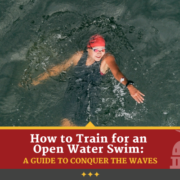How to Train for an Open Water Swim: A Guide to Conquer the Waves
 Open water swimming offers a unique thrill, combining the beauty of nature with the challenge of the unknown. Whether you’re diving into a serene lake, a rolling river, or the unpredictable ocean. For those used to the steady rhythm of a pool, the open water can seem a little intimidating. But with the right training and mindset, you can transform those nerves into excitement. Here’s how to get ready for your open water adventure.
Open water swimming offers a unique thrill, combining the beauty of nature with the challenge of the unknown. Whether you’re diving into a serene lake, a rolling river, or the unpredictable ocean. For those used to the steady rhythm of a pool, the open water can seem a little intimidating. But with the right training and mindset, you can transform those nerves into excitement. Here’s how to get ready for your open water adventure.
1. Get Comfortable with the Unknown
In the pool, everything is predictable—the temperature, the clarity, and those ever-present lane lines. Open water, on the other hand, is full of surprises: varying water temperatures, waves, currents, and the mysterious depths below. Start by familiarizing yourself with these new elements. If possible, find a local lake or beach where you can practice. Start with short swims to get used to the feel of the water and build from there.
2. Practice Sighting
One of the biggest differences between pool and open water swimming is the lack of visual markers. In the open water, you won’t have a wall to tell you when to turn, so you’ll need to learn how to “sight.” This means periodically lifting your head to spot a landmark or buoy that guides your direction. Practice this in the pool by incorporating sighting every few strokes. Remember to keep it smooth—lifting your head too high can throw off your body position and tire you out faster.
3. Work on Your Breathing
Breathing in open water can be tricky. Waves, other swimmers, and nerves can disrupt your rhythm. Practice bilateral breathing (breathing on both sides) so you’re comfortable no matter which way the wind—or waves—are blowing. This skill will also help you avoid getting a mouthful of water during the race.
4. Start Easy and Relax
When you first enter the water, take a moment to acclimate. Begin your swim at a comfortable pace, allowing your body to adjust to the conditions. Stay calm, focus on your breathing, and gradually increase your effort as you find your rhythm. Starting easy helps you conserve energy and build confidence as you settle into the swim.
5. Simulate Race Day
Nothing beats race day experience, but you can come close with a little preparation. In your final weeks of training, try to mimic the conditions you’ll face on race day. This includes practicing in the same type of water (lake, river, ocean), at the same time of day, and even wearing the gear you plan to race in. This will help you adjust to any potential challenges and build your confidence.
6. Prepare Mentally
Open water swimming is as much a mental challenge as it is a physical one. Visualize the course, anticipate the feel of the water, and mentally rehearse how you’ll handle any challenges. The more you prepare your mind, the more resilient you’ll be on race day.
7. Fuel and Hydrate Properly
Don’t forget that open water swimming can be more taxing than a pool swim, especially in colder water. Make sure you’re well-fueled and hydrated before you hit the water. Practice taking in nutrition during longer swims so your body is used to it.
8. Have Fun
Last but not least, enjoy the experience! Open water swimming offers a sense of freedom and connection with nature that you just can’t get in a pool. Embrace the adventure, and remember why you started swimming in the first place.
 Whether you’re gearing up for your first open water swim or aiming to improve your skills, these tips will set you on the right path. And if you’re planning to participate in the CapTex Tri, following these steps will ensure you’re ready to make a splash and conquer the waves!
Whether you’re gearing up for your first open water swim or aiming to improve your skills, these tips will set you on the right path. And if you’re planning to participate in the CapTex Tri, following these steps will ensure you’re ready to make a splash and conquer the waves!



